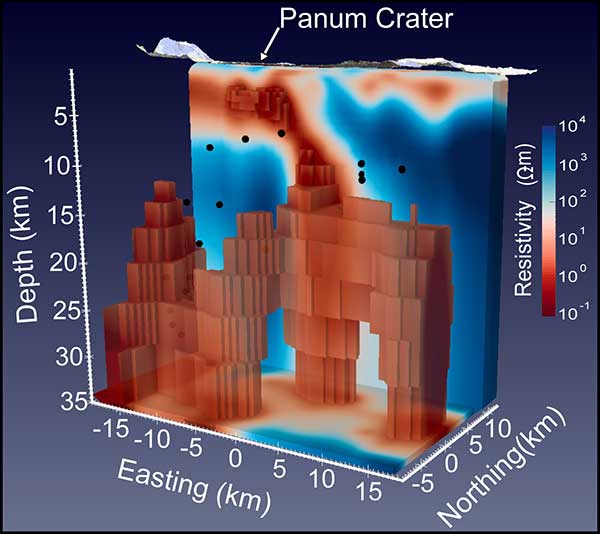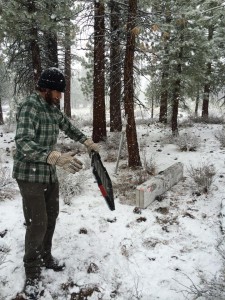29 October 2015
3D images of magma below Mono Craters
Posted by Lauren Lipuma
by Leslie Gordon

Looking north towards Mono Lake and Mono Craters from the summit of Reverse Peak.
Credit: Jared Peacock/USGS.
A new conceptual model of the magma system below Mono Lake and Mono Craters in eastern California gives scientists a more detailed understanding of volcanic processes at depth and a better model for forecasting volcanic unrest.
The Mono Craters volcanic area is ranked among the nation’s high threat volcanoes. Recent eruptions at Mono Craters occurred about 600 years ago at Panum Crater and about 350 years ago on Paoha Island in the middle of Mono Lake. The accuracy and high resolution of the new three-dimensional images of the magma chambers and volcanic “plumbing” below Mono Basin give scientists a better understanding of their size, shape and where the next eruption might occur.
To create the new 3D images, U.S. Geological Survey post-doctoral researcher Jared Peacock used a technology called magnetotellurics. The technology measures slight electrical currents naturally created by the movement of ions in the Earth’s magnetic field (like the Aurora Borealis, or Northern Lights). The flow of these electrical currents through rock varies based on the rock’s composition and other properties. Old, dense rocks at depth are more resistant to electricity flowing through them, whereas fractured rocks containing fluids such as groundwater or hydrothermal fluids related to volcanic activity are less resistant. Magma chambers with liquid, melted rock, or a partially crystallized “mush” have a very low resistivity to current flow.

A 3D resistivity model image (view looking northwest) showing anomalies below Mono Craters. The warm red and orange colors indicate material with low electrical resistively, and the cool blue colors indicate a high resistivity to an electrical current. Note the “giraffe’s neck”-shaped anomaly below Panum Crater. Black dots are earthquake hypocenters.
Credit: USGS.
The 3D resistivity images show at least two vertical magma columns 10 km (6 miles) deep. One column underneath Panum Crater, resembling the shape of a giraffe’s neck, veers off horizontally, suggesting the presence of hydrothermal fluids near the surface. The other column, below South Coulee, gives no indication of recent near-surface activity. An older body of granitic rock, a pluton, was also discernible amid the columns of younger magma in the 3D imaging.

USGS scientist Jared Peacock lays out magnetotelluric equipment in the snow.
Credit: Ryan Kogler/USGS.
Using the electrical resistivity model and data from previous scientific studies of the area, Peacock was able to shed light on a long-standing question of how the volcanic system may be related to nearby faults. Peacock observed a conductive anomaly west of Mono Craters that has been known as a site of long-period earthquakes. This correlation could be caused by either volcanic fluids from magma moving below the surface or the release of fluids from nearby metamorphic rocks that are under high pressure and temperatures. More research needs to be done in that area to determine whether the cause of the long-period earthquakes is due to magmatic (volcanic) or metamorphic processes. A determination could give insight to the possibility of future volcanic activity in a new area. The resistivity imaging also indicated how other small faults on the east side of the Sierra Nevada may be connected at depth and extend farther and deeper than previously known.
“These new 3D images add detail to our existing knowledge of the volcanic system east of the Sierra Nevada, and enable us to make more accurate forecasts of volcanic unrest,” said Margaret Mangan, Scientist-in-Charge of the USGS California Volcano Observatory.
Peacock’s research paper, “Imaging the magmatic system of Mono Basin, California with magnetotellurics in three-dimensions,” has been accepted for publication in the Journal of Geophysical Research – Solid Earth, a publication of the American Geophysical Union.
– Leslie Gordon is a Public Affairs Specialist/Geologist at USGS.
View the USGS press release on this paper here.










 GeoSpace is a blog on Earth and space science, managed by AGU’s Public Information staff. The blog features posts by AGU writers and guest contributors on all sorts of relevant science topics, but with a focus on new research and geo and space sciences-related stories that are currently in the news.
GeoSpace is a blog on Earth and space science, managed by AGU’s Public Information staff. The blog features posts by AGU writers and guest contributors on all sorts of relevant science topics, but with a focus on new research and geo and space sciences-related stories that are currently in the news.